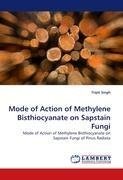
-
 Anglický jazyk
Anglický jazyk
Mode of Action of Methylene Bisthiocyanate on Sapstain Fungi
Autor: Tripti Singh
After harvest logs of pine, become susceptible to invasion by a variety of microorganisms, including wood discolouring fungi, which brings about significant losses in log quality. The discolouring fungi or sapstaining fungi are early colonisers and can infect... Viac o knihe
Na objednávku
73.17 €
bežná cena: 81.30 €
O knihe
After harvest logs of pine, become susceptible to invasion by a variety of microorganisms, including wood discolouring fungi, which brings about significant losses in log quality. The discolouring fungi or sapstaining fungi are early colonisers and can infect logs within as short a time as few hours as log harvest, causing blueish discolouration posing a major multi-million dollar economic problem for the wood industry. Effective control strategies often referred to as 'sapstain control' using antisapstain chemicals have been available to producers of unseasoned wood since the beginning of last century. Today research in this field focuses on the search for control options that are highly cost effective, environmentally benign, and thus strive to meet the global demand for reduced chemical usage. Methylene bis thiocyanate (MBT) based formulations have been used to control sapstain for some time. However, little attention is directed towards understanding the precise mode of action of MBT against common wood inhabiting fungi.
- Vydavateľstvo: LAP LAMBERT Academic Publishing
- Rok vydania: 2010
- Formát: Paperback
- Rozmer: 220 x 150 mm
- Jazyk: Anglický jazyk
- ISBN: 9783838350578












